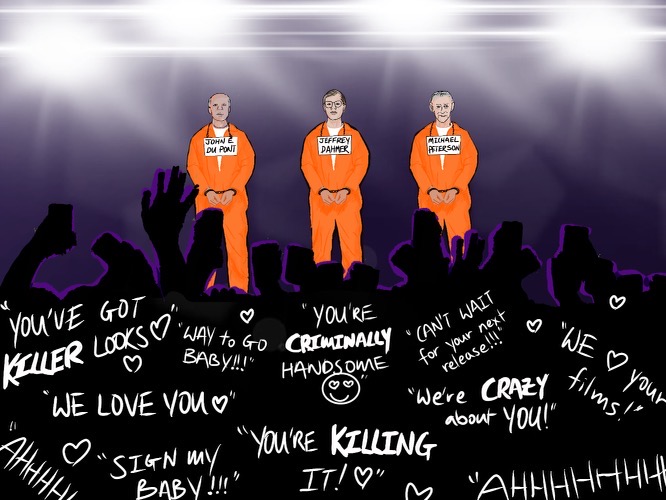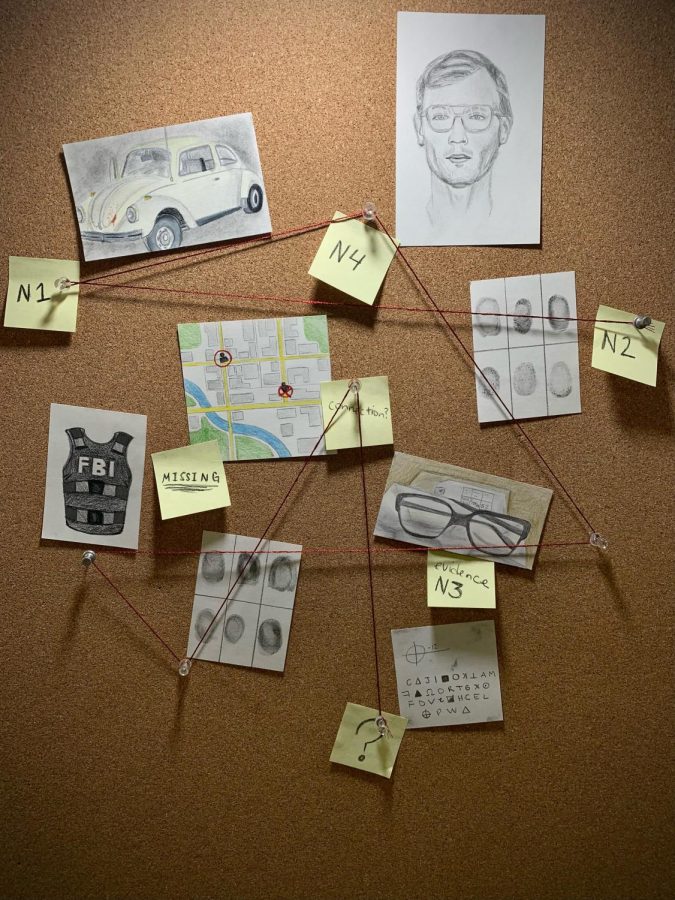Rise in media coverage incites true crime takeover in the United States
Obsessed with true crime? We’re caught red-handed
By Rachel Levine
Times are always changing; trends are ever-evolving. However, one questionable behavior that has remained eerily constant is society’s fascination with true crime. This craze dates all the way back to the 16th century, when individuals would embellish pamphlets consisting of frightening crimes, all in the name of entertainment.
In the grand scheme of things, not much has truly changed. People around the world today still dissect the lives and atrocities surrounding serial killers.They invest themselves in murder mysteries and nightmare-worthy thrillers; however, the chill-inducing content has transformed from written tales to live-screen productions with detailed graphics. Although the popularity of true crime creations has been prevalent for years, the plethora of these films and series overflowing streaming platforms in recent months has opened the world’s eyes to how widely viewed these programs truly are.
Unfortunately, the world we live in can be a terrifying place at times. The atrocities that devastate our world far too often are accurate representations of life in the present day, causing viewers to be drawn to these disturbances of reality. This causes people to evaluate our society and attempt to decipher why these calculated events happen in the first place.
In particular, true crime fans are intrigued by documentaries portraying serial killers, deeply invested in their motivations. These are real people: real, twisted humans who walk the same Earth we wake up on every day. People are interested in realistic depictions, and true crime creations in the media are, tragically, very real.

Criminal curiosity has taken root in Americans
By Lindsey Leitner
The unknown is fascinating. But what can be even more unbelievable is the truth.
America loves horror movies, and true crime flicks can capture an audience’s attention until the last second. What people fail to recognize is the reality involved. As many times as the screen shows “based on a true story,” many still cannot comprehend that these events actually happened to people like them. Instead, viewers use the traumatizing experiences of others for the simple reason of eliciting emotion. Feeling the terror as they watch allows “normal” people to face something that would not otherwise exist in their lives—as false as this often proves to be.
In addition to shocking reactions, these stories provide insight into issues faced by everyone in different ways. Whether it’s how characters deal with their anxiety or the way in which victims act in response to their fear, people tend to feel more comfortable if they see others behaving the same way.
Part of the reason for this common obsession is the idea of not being scared of something others can’t stand to watch. The criminal mind terrifies some people. Watching these events take place, realistic or not, can cause all kinds of reactions. By appearing above this fear, viewers often get a sense of pride and an ego boost.
Similar to the allure of good and evil, people are captivated by the fine line between interest in crime and the fear of it. More often than not, this feeling of “not me” when witnessing terrifying events gives them a false sense of security.
Everyone has their own issues and suffers from their own personal trauma, no matter how big or small. Watching true crime from the outside allows a view into others experiencing similar emotions on a larger scale. Anxiety, depression and fear—all sometimes seen as irrational—can take over one’s thoughts and actions until they dissipate. Seeing this happen without feeling alone in the experience encapsulates the attention of the audience until everyone is hooked.
Society feels the impact of your guilty pleasure
By Brooke Murphy
The popcorn is popped, your feet are up on the table and your favorite show is on. It’s “Dateline,” and the sounds of gunshots, stabbings and gory crime details put you right to sleep. But how does this common indulgence impact society?
The sinister details featured invoke feelings of disgust and fear that have become a major part of the appeal. The more viewers watch, the more desensitized they become to the most gruesome crimes. This causes a romanticization of the storyline as viewers become fascinated with the lives and brains of criminals. Serial killers such as Jeffrey Dahmer, John Wayne Gacy and Ted Bundy have long been analyzed by professionals and the general public.
“Criminal Minds” is one example of a series that dives deep into the psyche of criminals and their modus operandi. This often connects murderers, arsonists and rapists to titles such as “psychopath” and “sociopath,” causing those unaware of the real medical diagnosis antisocial personality disorder (ASPD) to associate them as “criminal disorders.” Though symptoms often include criminal acts like stealing or vandalism, public perception doesn’t pinpoint much distinction between ASPD and sadism.
Though in many instances it stigmatizes mental health, true crime can also bring awareness to issues in the criminal justice system. “Conversations with a Killer: The John Wayne Gacy Tapes” exposes that multiple victims of the serial murderer worked for him. The disappearance of these young men were not connected to Gacy until their bodies were found under his crawl space. They had families who knew who they worked for, but because Gacy was well-liked by the community, no one suspected him. If this simple connection had been made, future victims could have been saved.
Netflix’s “When They See Us” depicts how five young African American and Latino boys were tricked into making false confessions and incriminating statements during hours or even day-long interrogations. After serving years in prison for the rape and assault of a jogger in Central Park, the men were released on account that the real perpetrator had been linked through DNA evidence.
The Netflix series “Monster: The Jeffrey Dahmer Story” has a similar impact. The show exposes how the actions of the NYPD facilitated Dahmer’s killings. He thinly escapes being caught on many occasions, mostly due to homophobia and racism from officers called to the scene.
Yet, this awareness is often not up to the families of victims, and their emotions are constantly disregarded for monetary gain. Reenactments like the Netflix Dahmer series often incorporate little to no first-hand accounts or interviews and rely solely on acting, creating the feel of a fictional piece. This personalizes criminals, drawing the focus away from the stories of the victims.
Many families of the victims have come out to say that certain details were added for dramatic effect. Rita Isbell, sister of Dahmer’s victim Eroll Lindsey, told Insider that she was “deeply disturbed” to see a recreation of her speech during Dahmer’s court case, one of the most traumatizing moments of her life.
While the Damher show might entertain curious minds, it’s yet another reminder of a delicate, disturbing and tragic situation. As Isbell’s cousin tweeted, “It’s retraumatizing over and over again, and for what? How many movies/shows/documentaries do we need?”
Although true crime reveals injustices and symptoms of a killer, it also stigmatizes mental health and traumatizes those connected. These stories are more than entertainment, and viewers need to consider that.













